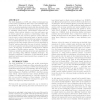Free Online Productivity Tools
i2Speak
i2Symbol
i2OCR
iTex2Img
iWeb2Print
iWeb2Shot
i2Type
iPdf2Split
iPdf2Merge
i2Bopomofo
i2Arabic
i2Style
i2Image
i2PDF
iLatex2Rtf
Sci2ools
EDBT
2010
ACM
2010
ACM
Querying trajectories using flexible patterns
The wide adaptation of GPS and cellular technologies has created many applications that collect and maintain large repositories of data in the form of trajectories. Previous work on querying/analyzing trajectorial data typically falls into methods that either address spatial range and NN queries, or, similarity based queries. Nevertheless, trajectories are complex objects whose behavior over time and space can be better captured as a sequence of interesting events. We thus facilitate the use of motion “pattern” queries which allow the user to select trajectories based on specific motion patterns. Such patterns are described as regular expressions over a spatial alphabet that can be implicitly or explicitly anchored to the time domain. Moreover, we are interested in “flexible” patterns that allow the user to include “variables” in the query pattern and thus greatly increase its expressive power. In this paper we introduce a framework for efficient processing of flexible ...
| Added | 28 May 2010 |
| Updated | 28 May 2010 |
| Type | Conference |
| Year | 2010 |
| Where | EDBT |
| Authors | Marcos R. Vieira, Petko Bakalov, Vassilis J. Tsotras |
Comments (0)

